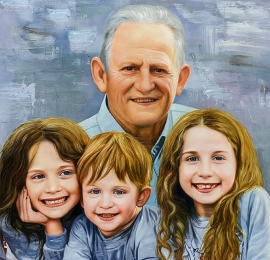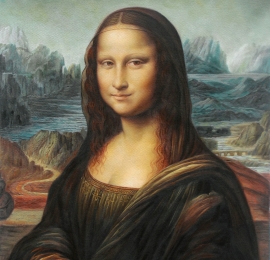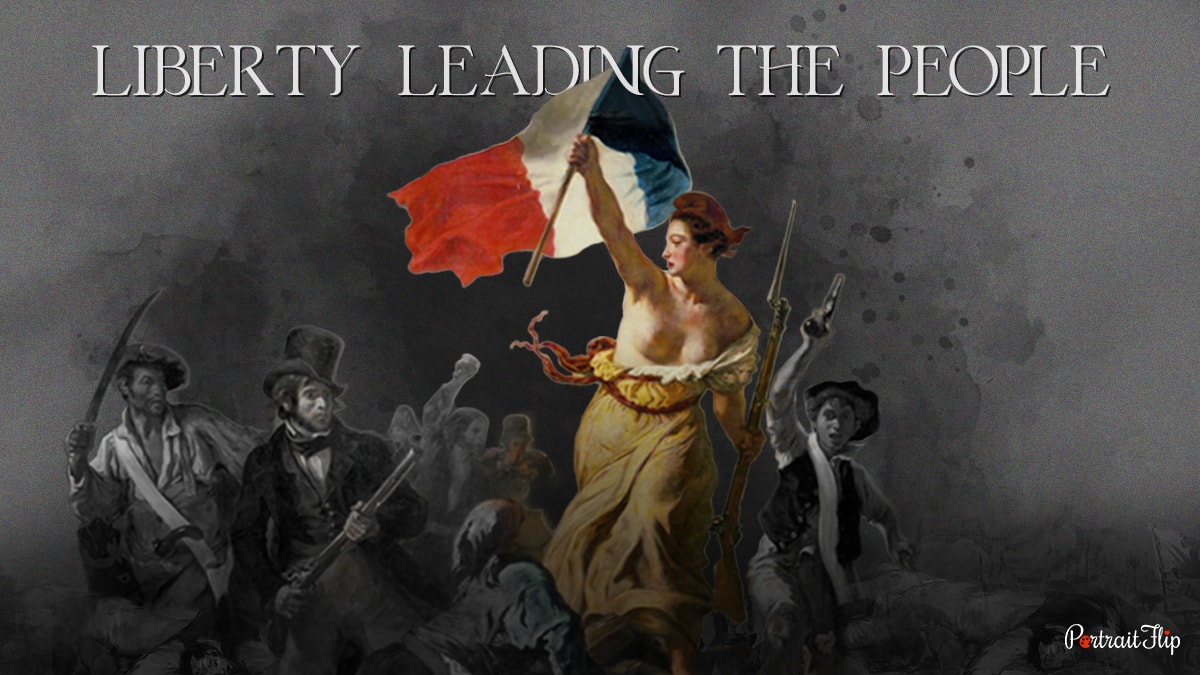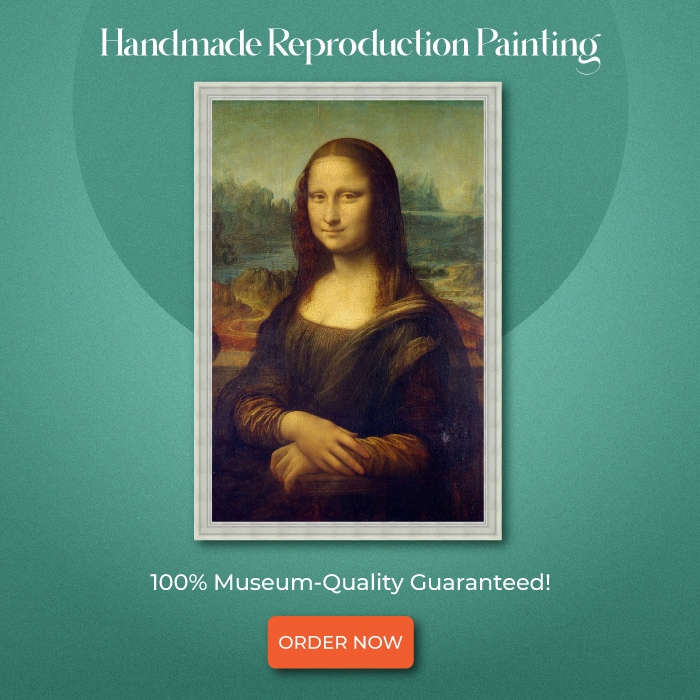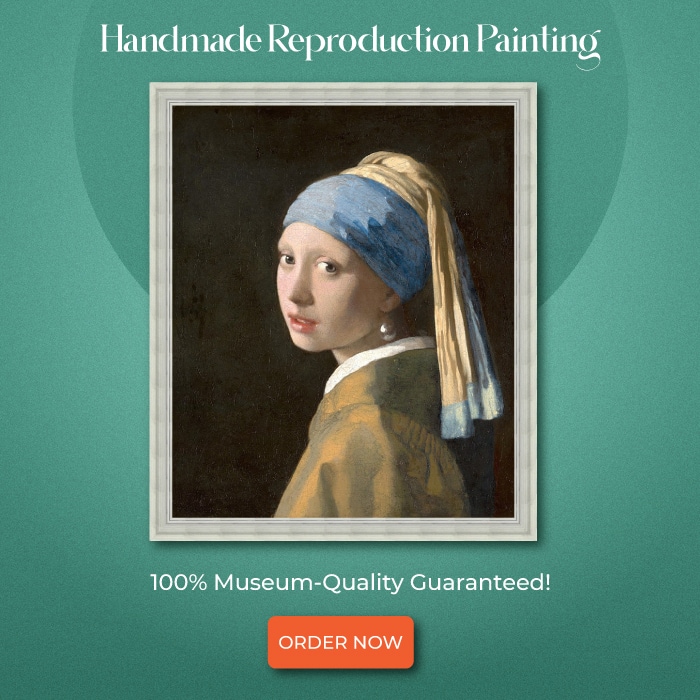The artwork is defined as the idea or thought that the artist had in the first place.
Some paintings depict fantasy, some stories, and some historical events that make the viewer question what exactly happened.
The events that are later marked as the most important days in history always have different aspects related to them.
Have you ever been into the political arts?
The most famous political painting, “Liberty Leading the People,” is an excellent work that showcases a glimpse of what must have taken place.
You must have heard the name, do you know the exact event that led to this historical painting?
Not in-depth, right?
Why not learn all the history, impact, and thought that created this piece of art?
Here we have covered the entire scenario that eventually gave birth to the famous French art—Liberty Leading the People.
Table of contents
I. History
A work that is so renowned always has a spicy backstory.
The history of art and the artist are two important aspects.
Let’s acknowledge them!
1. The Romantic Artist
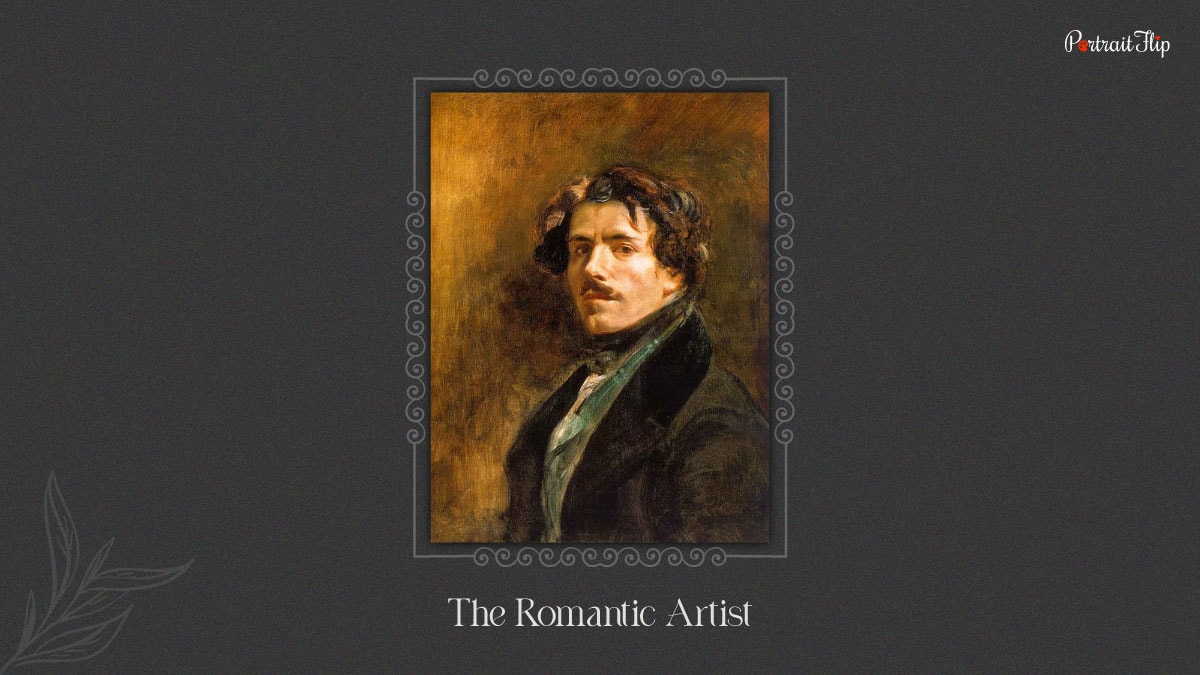
Who was Eugene Delacroix?
A famous French artist who was a pioneer of Romanticism art and an influencer of the Impressionists.
He was known as the “master of colors” because of his use of vibrant and energetic shades in his artwork.
Delacroix had a successful career, along with the countless commissions he received.
Eugene Delacroix’s “Liberty Leading the People” painting marked a change in the world of art.
Many were offended by the art and criticized it leaving very little room for people to like it.
In today’s time, Deloacroix is known as one of the most influential artists of romanticism.
2. The Political Art – Liberty Leading the People
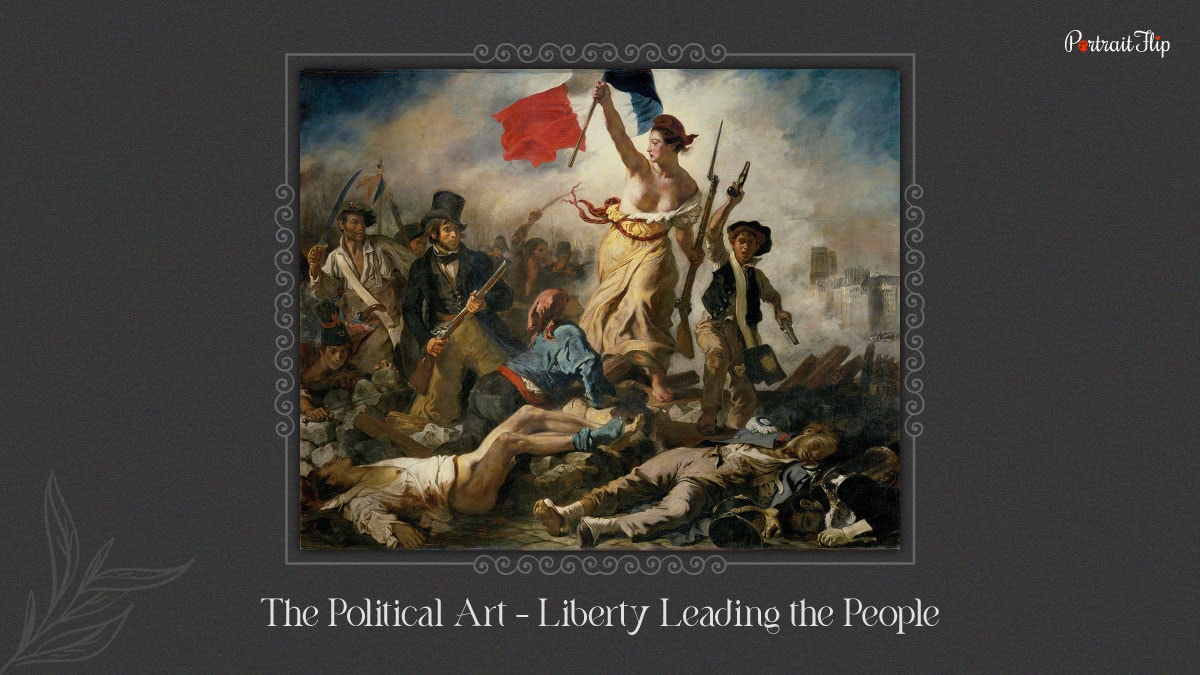
On July 28, 1830, this masterpiece was produced and changed the whole perspective of the people.
Painting of Delacroix brought this historical event to canvas with great pride.
It depicts the story of Trois Glorieuses which is also known as the July Revolution.
Eugene Delacroix was touched by three days of rioting and the fight for freedom.
As a painter, he decided to incorporate those events into a painting, which turned out to be a glory in Eugene’s career.
The painting is a personification of a rebellious, bare-breasted woman who is leading the people towards victory.
It also has an alternative name that is “Liberty on the Barricades.”
II. Time Period
Do you know the painting Liberty Leading the People is basically a depiction of revolution?
Not only that, the revolution started way before the actual art came into existence.
Curious to know more? Let’s have a closer look at it!
1. French Revolution
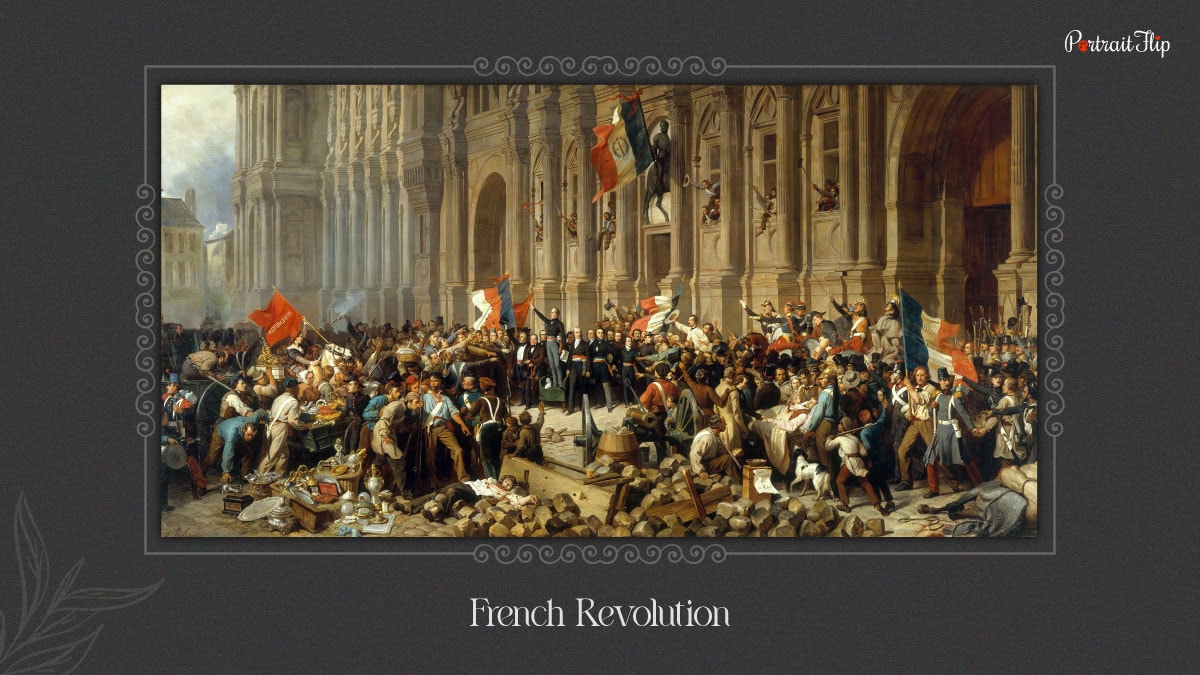
The revolution officially kicked off with the Storming of the Bastille on July 14, 1789.
This was the era of social and political disturbance that absorbed the entire country.
A group of rioters invaded in order to have access to the gun powder.
But why were these rioters being so rebellious?
With the high amount of tax and underpaid system, the people of France were not able to sustain a normal life.
Due to the royal family’s excessive wealth, the people were suffering.
This reason led to the battle during that period of time, which continued for almost ten years.
“Liberty Leading the People” could also be known as a French Revolution painting of the late 18th century.
But it was not the end of the conflict!
Sometimes, revolutionary moments are needed to be captured in a frame. Just like the French revolution, another significant military moment can be painted and kept forever!
Check Out Our Military Paintings!
2. July Revolution
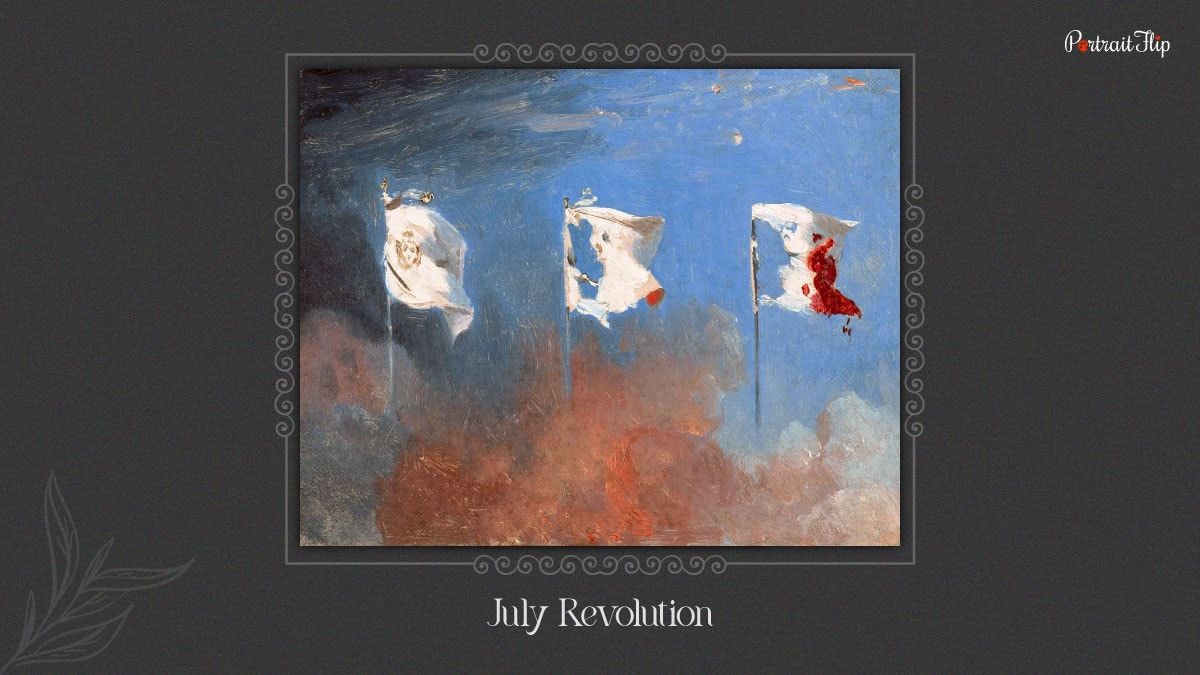
The July Revolution was the sequel to the French Revolution.
Delacroix painted Liberty Leading the People in 1830, the same year when the July revolution took place.
But do you know why it is called Trois Glorieuses?
Trois Glorieuses means “Three Glorious Days,” which eventually led to a conflict that took place on July 27th, 28th, and 29th.
On a simple note, the battle was still on among the people of France.
Those three days were the final resolution to come to a point about who would rule France.
Eventually, Louis Philippe was chosen as the new ruler of France with the end of Charles X’s ruling era.
This verdict brought a new set of rules and a brand new constitution to France.
The whole event was so overwhelming that Eugene was highly inspired to bring his brush to the canvas to develop a masterpiece like “Liberty Leading the People.”
It’s kind of strange that a single frame has the power to describe plenty of emotions!
III. Formation of the Art
Now, you are familiar with what exactly inspired Eugene to paint such an artwork.
But the question that strikes the mind is what components were involved to form the art, Liberty Leading the People, in the manner it is shown? Let’s find out!
1. Genre of the painting
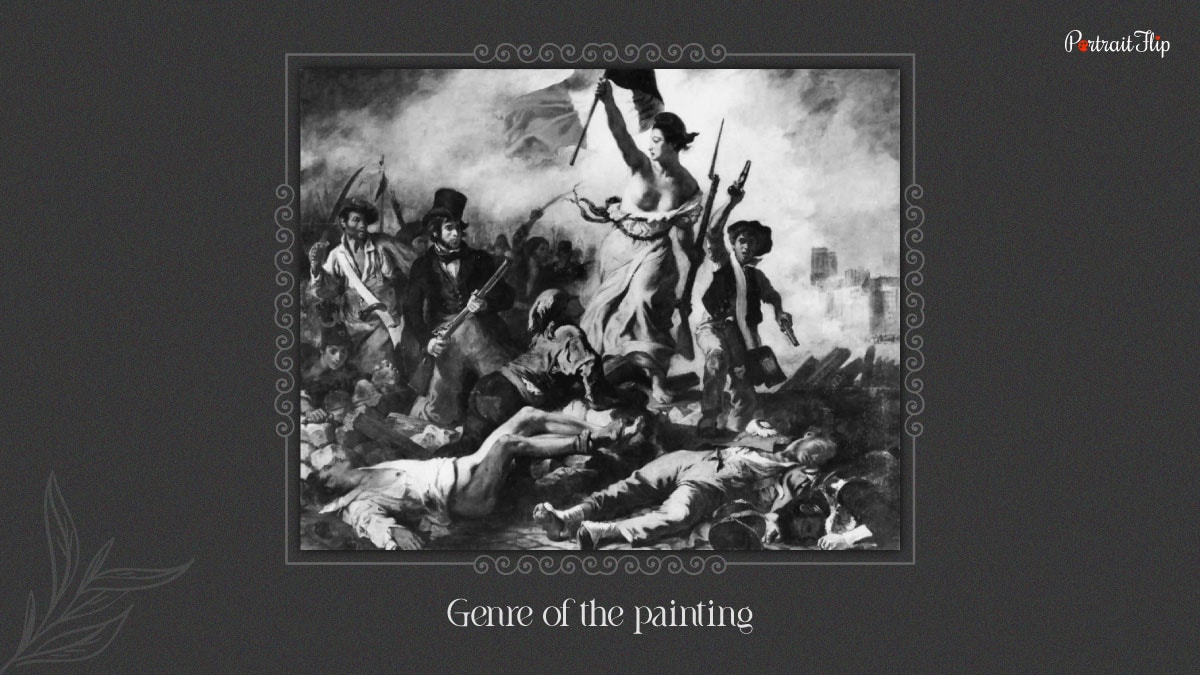
The genre is one of the aspects that speak about the art.
Liberty Leading the People falls under the category of “history painting.”
Eugene being Liberty Leading the People painter, decided to create a work that depicts the whole scenario of the revolutionary period.
A painting whose subject revolves around classical events is something that could relate to a genre like historical artworks.
2. Art Period
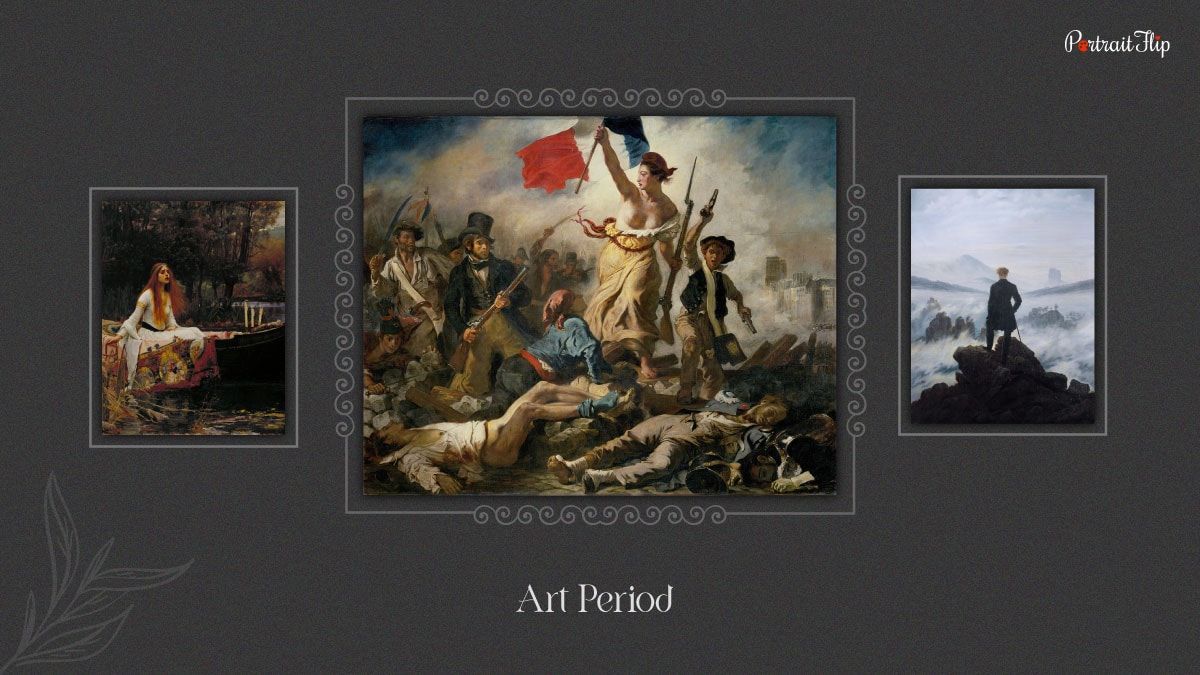
Have you heard about the “Romanticism Art Period?”
In simple terms, this art period speaks about the freedom to express the emotions, feelings, and connections that happened.
Most people view romanticism period as the predecessor of the Neoclassical movement.
But Liberty Leading the People belongs to the Romanticism paintings and movement.
Eugene was well known for romantic paintings, which somehow are depicted in this Liberty artwork.
An art that is full of emotions and feelings gives a sense of patriotism, where the lady leading people makes a path.
The piece showing heroism, angry faces, human emotions, and salvation brought a different touch altogether.
Romanticism is not just love between two people. It can be among any two individual things.
The eternal love for the country is what Eugene tries to show through his vibrant colors.
This artwork belongs to one of the paintings of romanticism, which holds a position in the top ten.
IV. Symbolism
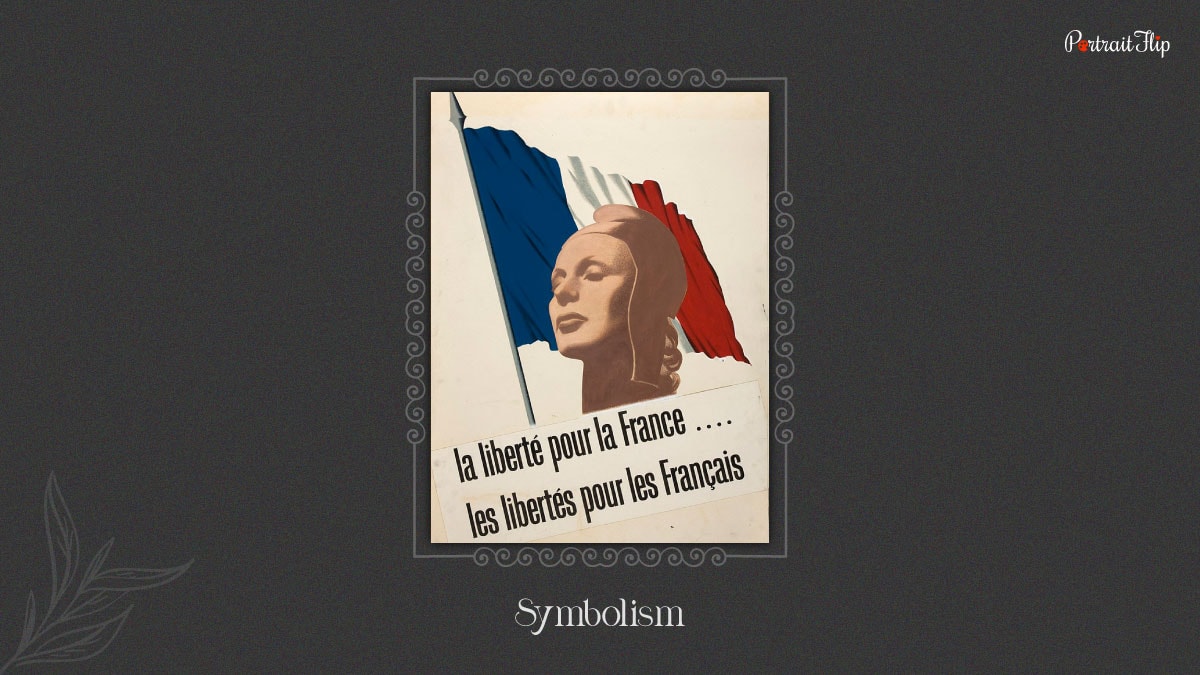
Symbolism gives the painting a direction for the viewers.
Describing the art in a way that is understandable for the audience is an essential part.
As the name suggests, “Liberty Leading the People” is an allegorical painting that depicts freedom and democracy.
The emancipation of people from excessive dominance is also one of the concepts shown in the painting.
The faces of the characters, which are in pain, anger, and suffering, are the message that Eugene wants to convey through his art.
The symbolism of the painting sometimes lies in the meaning of its title.
What personal feelings does the artist depict in the image above?
The image above has a small note added to it that says, “Freedom for France…Freedoms for the French,” which was the motive of the conflict.
V. Visual Representation
How does art take form? Do you know the answer to this question?
Well, the compilation of minute details that led to the bigger picture is how art evolves.
Let’s examine them!
1. The Woman
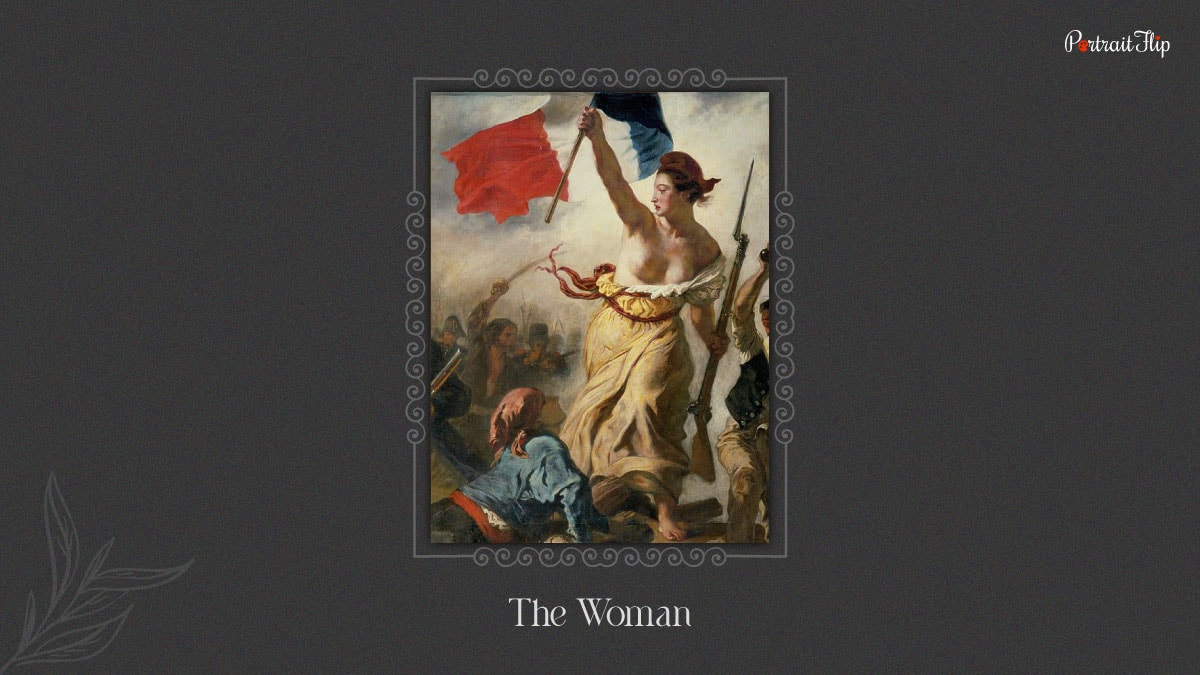
If we look at the Liberty Leading the People analysis, then it can be described as a dramatic scene with intense activity.
The main character—the woman who is leading the people and showing them the path they have to follow—is the central figure.
With a long yellow dress holding the Flag of France and bare chest exposing the breast, the figure gives out a bold look.
She appears to be the most powerful character in the painting and is moving forward with force for the purpose of providing liberty to the people.
2. Male Figures
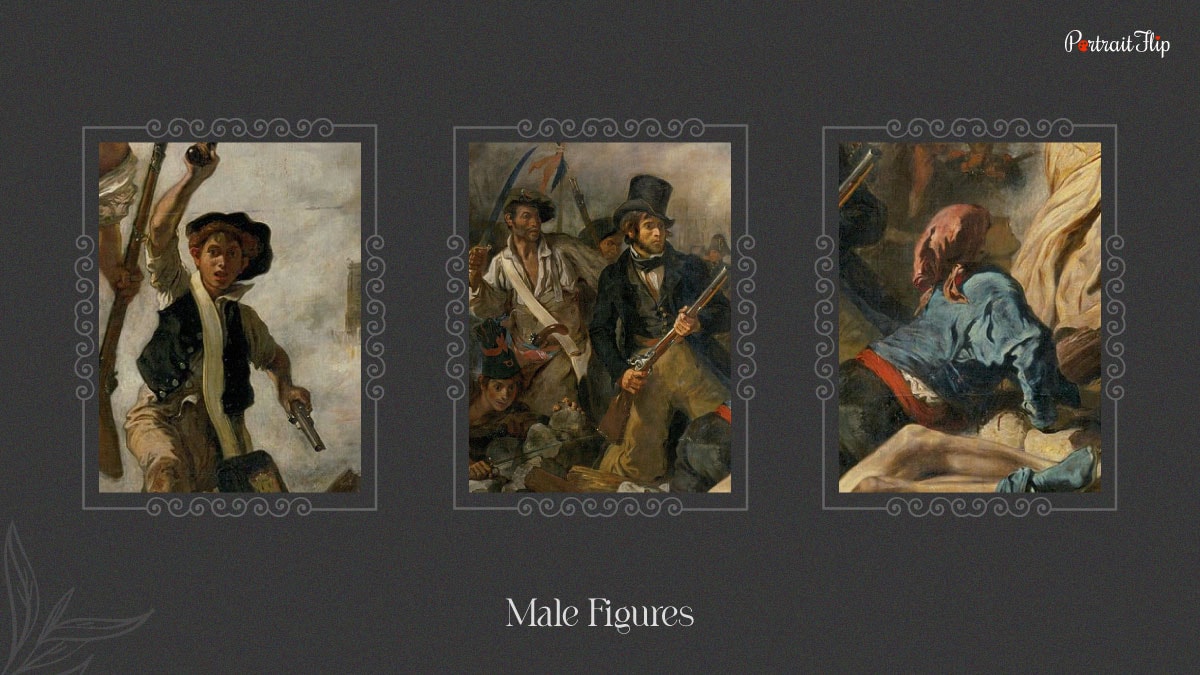
It is easy to catch a glance at the men surrounding the woman and following her steps.
But if you look closely at each man, you will observe a contrasting tale.
To the right, there is a boy, who is shown as a “young man,” holding a small gun in both of his hands.
This indicates how the environment has compelled the people around.
A young boy holding guns indicates the insurgents of new youth with rebel feelings at such a young age.
To the left, two notable adult male figures are observed.
One man’s clothes depict a lower class, whereas the other man showcases just the opposite by being well dressed.
Delacroix wanted to portray to the viewer how people from different classes came together to battle for their rights and a better society.
He tried to show that the revolution was not about the lower classes fighting with each other but about the people opposing royalist persecution.
If you look in a downward direction, there is another man crawling towards the lady as if she is the figure of salvation to him.
The dead bodies all over the ground give the painting a view of battle.
Sacrifice, love, loyalty, and dedication for the country in order to create a place for a better life is what Liberty Leading the People portrays.
VI. Star Figure of the Painting
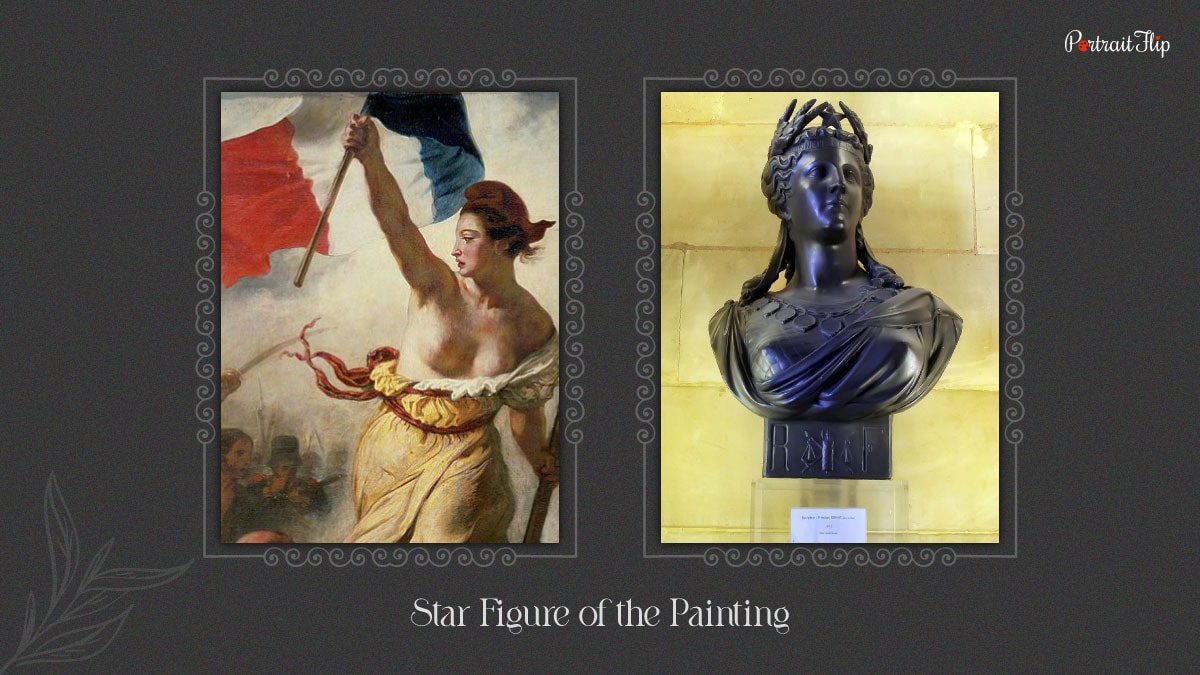
You know who the star figure in Liberty Leading the People is!
Yes, it’s the lady that is holding the flag of France with an expression of leadership on her face.
But do you know who she represents and why is lady liberty bare-breasted?
The woman here speaks for Marianne, a lady who is a symbol of the French Republic.
She appears as the top of a pyramid who is walking forward gracefully, showing the people the path to freedom.
The bare-breast view pass out the power of liberty and draws people attention which entice people.
While giving a closer look to the lady, you will discover a maroon color cap on her head. Do you know what it stands for?
The red Phrygian cap signifies the symbol of freedom.
Eugene was clear with his thoughts about how to depict the Republic in a way that it would have an impact on the viewers.
As a French artist, he used the most powerful figure of France in his art.
Delacroix once mentioned that he couldn’t participate in the battle field but would contribute the scene in his painting that will be heard and seen by the people for centuries.
VII. Shapes & Form
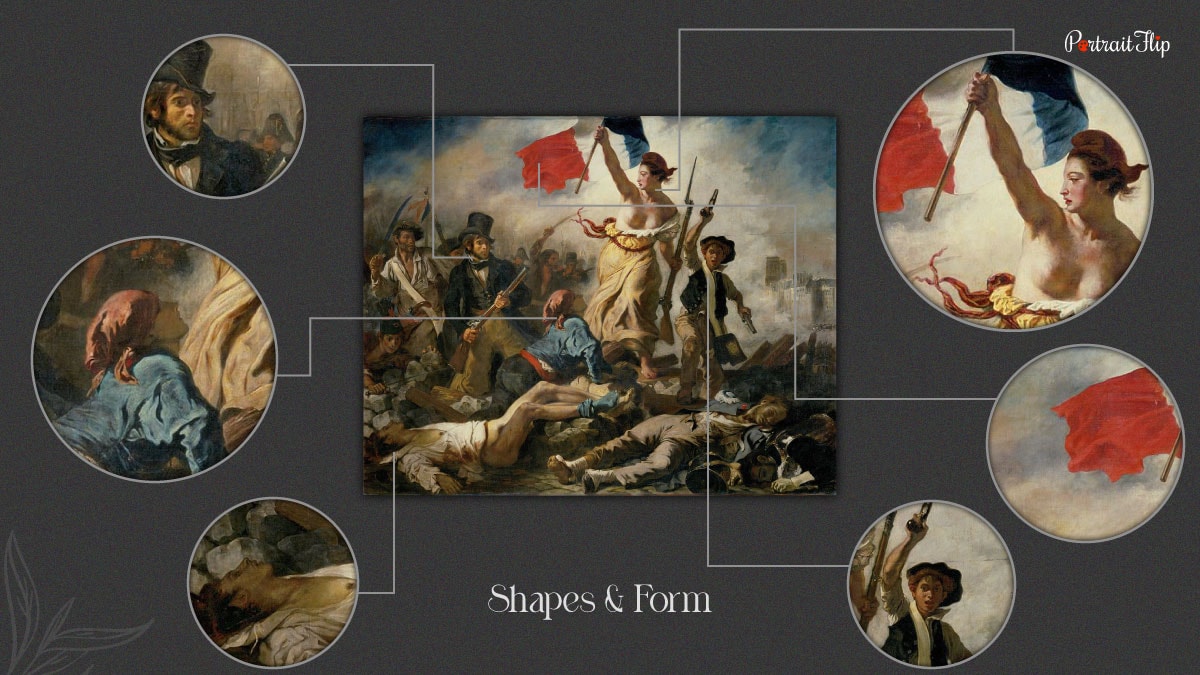
Delacroix used his special way to incorporate the action of the July revolution.
When it comes to the question of why Liberty Leading the People romanticism or considered as romantic art, it includes only one phrase—its decoration!
The colors, light, and techniques bring out an emotional response from viewers.
A painting is meaningful due to the small details added to it.
The combination of shades and brush creates an exceptional effect.
Below is the division of the textures used by Eugene that speaks about art and the artist’s thinking.
1. Color Palette
People have a notion that art that depicts a field of battle needs to be in a dark zone.
Eugene was careful while using the vibrant color for the painting that was about a war.
He developed his own way of showing pain and suffering in his art through vivid and bright colors.
Have you noticed the colors used in Liberty Leading the People?
The bright colors of red, white, and blue are the most used in the painting.
He repeats the color format in order to highlight the power of France and the unity among the people.
Eugene has given the revolutionaries the echoes of color to connect with Lady Liberty.
To mark a difference, it was important to highlight the point that all classes came together to achieve the same goal.
As the painting is conveying a message of freedom, the use of vibrant colors could be a symbol of liberty, joy, success, and unity among the French people.
2. Use of Light
The part of the art that draws a viewer’s attention is because of the use of light in that particular area.
Which part of the painting first caught your attention?
Lady Liberty, right?
I will explain to you why!
The lady is the main character in the painting.
Eugene has illuminated the woman with the effect of bright sunlight on her face, which emphasizes her power.
He has kept the light around the lady more vivid, which indicates the rays of new hope.
This grabs the attention of the viewers.
The use of smoke behind the characters is another brilliant idea that makes the painting more authentic.
3. Brushwork
The use of brushwork narrates the whole story that the painting wants to portray.
The mood, tone, and emotions of the character cover almost the entire idea behind the artist’s mindset.
Delacroix used brushstrokes to describe the emotional rhythm of the revolutionist.
Each stroke gives an indication of freedom, power, and victory.
While giving the art a closer look, you will observe that Eugene has used small, long, and independent brushwork.
This influenced the Post-Impressionist artists such as Van Gogh and Paul Cezanne to use this type of brushwork in their art.
Depicting the tone of victory while paying tribute to the people who sacrificed their lives in the battle is an astounding work by Eugene.
4. Techniques
Liberty Leading the People is an oil painting.
If you observe, a pyramid is created, with the lady being at the top of the pyramid.
Eugene has used the pyramid technique to structure the artwork, which gives the lady lead and power.
Delacroix knew the strategy that gives heed to the lady who stood still, coming up strong and victorious.
VIII. Inheritance
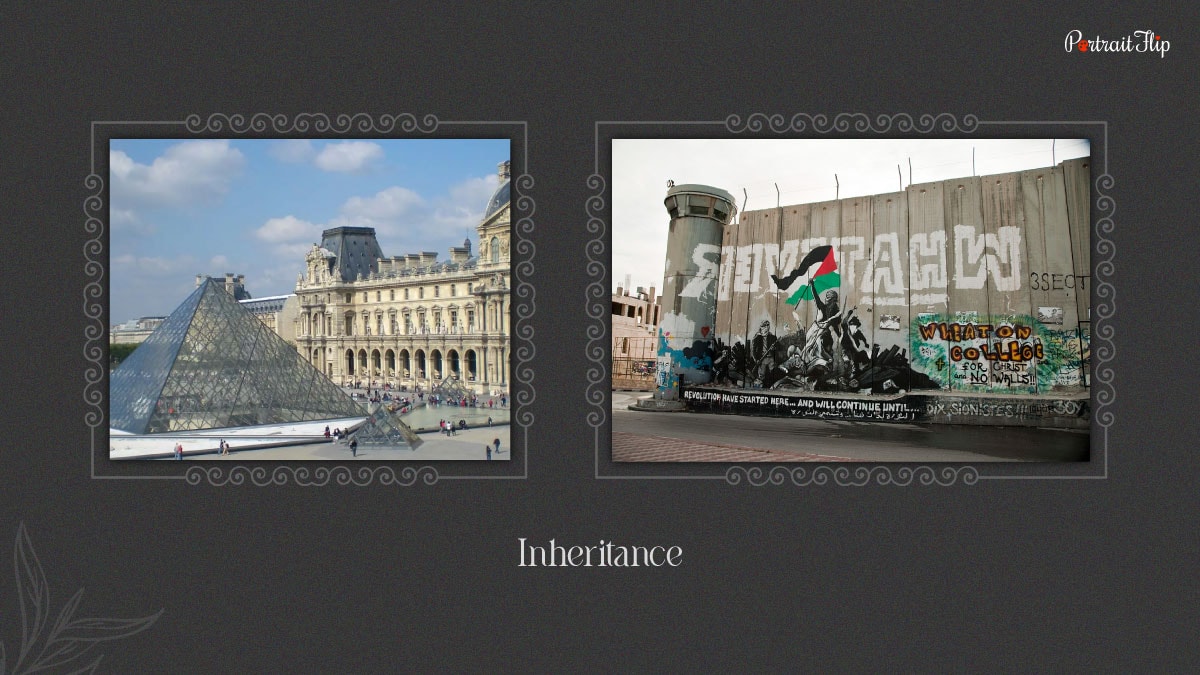
Which painting doesn’t have a legacy attached to it?
From my point of view, a legacy describes the reception of the artwork and its worth.
The list below highlights the honor of painting Liberty Leading the People:
People Inspired by Painting
- The painting influenced the novelist Victor Hugo to write about the French Revolution art, which was published under the name Les Misérables.
- The most famous sculpture, “Statue of Liberty” is said to be an inspiration from Liberty Leading the People. Frédéric Auguste Bartholdi was highly inspired by the work of Delacroix.
- It also influenced the classical musicians such as George Antheil in his Symphony no. 6 After Delacroix.
- The cover of the book “Enough is Enough: How to Build a New Republic” by Fintan O’Toole set out a view of the art. If you are a bibliophile, you can get the edition from here.
Reception of the Painting
- An imprint along with Eugene’s depiction was featured on a 100 franc note.
- After the death of Eugene, the painting was sent to Musee du Luxembourg in 1863.
- Liberty Leading the People being one of the paintings in the Louvre museum became exclusively famous after the transfer from Musee.
- In 1831, the painting was sold for 3000 francs, which is a huge amount considering the time period.
IX. Its Appeal Today
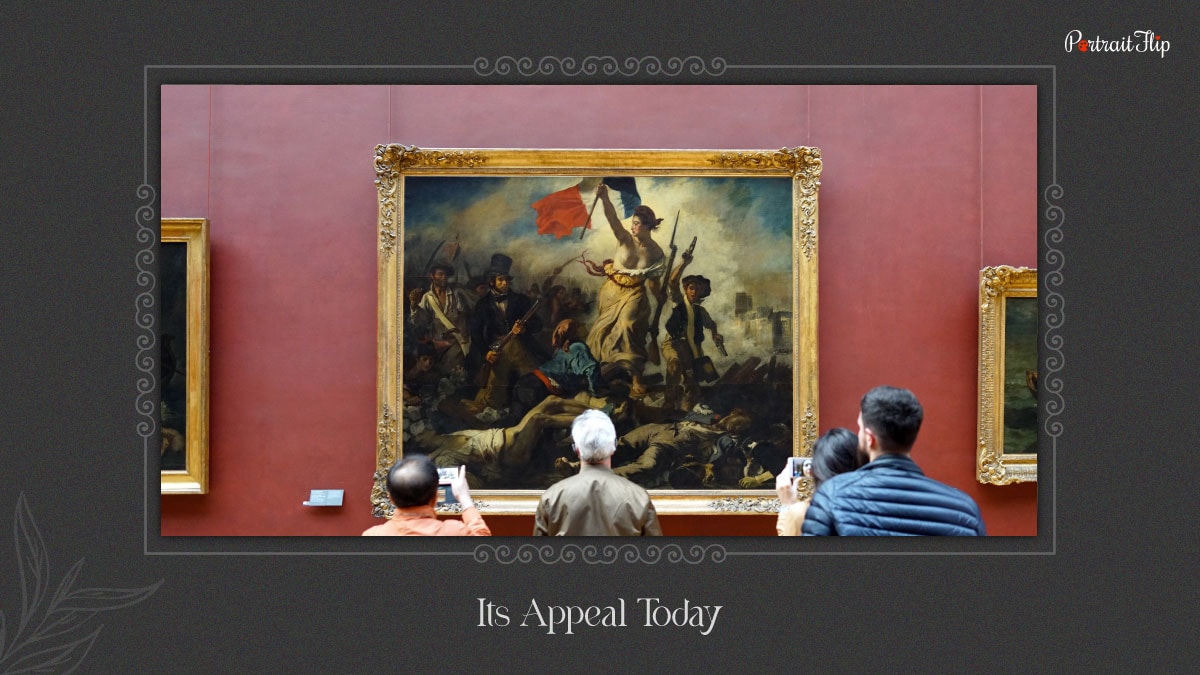
Some paintings introduce new forms in art, and some change the perspective of the world.
There is always a personal insight about the artwork apart from what it actually depicts.
Liberty Leading the People has become a universal masterpiece by Delacroix Eugene.
It is admired as one of the romantic historical paintings that gives the audience an idea about what would have happened during the July Revolution.
If we talk about the original cost of the painting, which, from my point of view, is beyond one’s imagination!
Bonjour Art Lovers
Thank you for reading my blog, “Liberty Leading the People – A Battle Through Eugene’s Eye.”
I have tried to include all the relevant information and facts which you may find helpful.
You can reach out to me via comments in case you find any difficulties regarding content.
Your valuable feedbacks are always welcome. Do let me know what you think about the blog!
And if you are a writer, you can even give your personal opinion about the blog or painting at- [email protected]
I’ll be curious to know and learn from a different perspective.
Finally, follow us on Instagram, YouTube, and Pinterest, where you can find incredible handmade paintings.
Keep exploring!
FAQs
The most famous sculpture, the Statue of Liberty, was inspired by this painting by Eugene.
No, the woman represented in the artwork is a symbol of freedom and not a real person.
The alternative name of the painting is “Liberty on the Barricades.”
The role of the art was to symbolize the liberation of the French people from oppressive domination.
Marianne is a national personification of the French Republic, which is shown via the lady as the main character in the painting, leading the people towards salvation.

